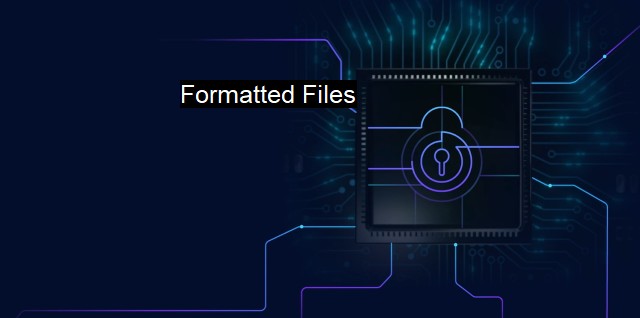What are Formatted Files?
The Importance of Formatted Files in Cybersecurity: Ensuring Interchangeability, Protecting User Data, and Staying Ahead of Evolving Threats
Formatted Files are files stored or used under a well-defined template or specific structure, which makes it easier for specific applications to process the associated data. These files can contain various types of data, which include text, images, charts, audio-visual data, and many more, organized in an arranged and prespecified manner. Any changes to this formatting, or the format of such files, often prevent the application from appropriately comprehending or using the data. A few commonly known types of computer-formatted files include PDFs, Microsoft Word files, excellent spreadsheet files, JPEG, and PNG files.The use and handling of formatted files are crucial since neglecting their security can lead to damaging consequences. This is because these files are potential carriers of intrusive elements like viruses, spyware, ransomware, and sometimes even malicious software modules coded to perform unintended and unauthorized actions.
An astute exploration of the cybersecurity domain reveals ways through which cyber attackers misuse the susceptibility of formatted files. A particularly harmful method is introducing harmful code snippets within these files, which upon opening could potentially allow the unauthorized takeover of your computer system.
Formatted Files are particularly concerning in the context of cybersecurity due to their ubiquity and broad acceptance across platforms and software. Cyber attackers exploited this trait and consequently used these to deliver malicious payloads that bypass standard security checks. For instance, cyber attackers could hide malicious code within a formatted document such as a Word file (.docx) or PDF file (Portable Document Format). When an unsuspecting user opens the document, it exposes the underlying system to potential vulnerabilities and risks.
It’s worth mentioning that sometimes such harmful components within formatted files may not directly cause damage. Instead, their functionality could be confined to creating backdoors within secure infrastructures, stealing sensitive information, tracking user activities, or even facilitating more substantial attacks.
Antivirus programs play an essential role in the risk management and safety of these formatted files. They perform automatic checks and scans on these files to check for known patterns often associated with harmful activities. If detected, antivirus programs either block access to such files, quarantine them, or delete them, thus ensuring that the harmful components do not infiltrate the system.
Antivirus applications can also active scan attachments in emails or downloaded files, checking specifically for malignant formatted files. This bridges risk management and antivirus application role gaps, plus cybersecurity protocols in place.
On another note, code obfuscation techniques used in formatted files allow hackers to hide their malicious intentions effectively. Such obfuscation often leads to the virus or malware lying latent, only activated through a specific trigger that often goes undetected by security systems, thus bypassing the conventional security checks in place, creating an enormous scale of potential damage.
Therefore, it is of paramount importance for businesses, organizations, software developers, and individuals to evaluate and manage the risks associated with formatted files consciously. This can be achieved by fostering an astute awareness of the potential damages, adopting robust preventive measures, and training employees to identify and deal with such threats effectively.
Though the existent threat associated with formatted files cannot be wholly negated, prompt recognition of the risk combined with concerted effort can significantly decrease the percentage of successful formatted files-related cyber attack instances. Emphasize preventative measures, such as using trusted antivirus software, avoiding unsolicited file downloads, and regularly updating all software infrastructure, are standard yet powerful ways to ensure such security. the adoption of a healthy attitude stressing security while dealing with cyber-threats, both known and new, cannot be understated.

Formatted Files FAQs
What is a formatted file in cybersecurity?
A formatted file in cybersecurity refers to any file that has been manipulated or altered in a way that changes its original structure. It can also be a file that has been processed to fit within a specific format or structure.Can formatted files be harmful to my computer?
Yes, formatted files can be used to carry malware or viruses that can harm your computer. Cybercriminals can use formatted files to trick unsuspecting users into downloading and running malicious code.How do I know if a file is formatted?
To check if a file has been formatted, you can look at its attributes or characteristics. A formatted file may have a different name, file extension, or file size from the original file. It may also have been compressed or encrypted to hide its true identity.How can I protect my computer from formatted files?
To protect your computer, make sure you have a reliable antivirus and anti-malware program installed. Also, avoid downloading files from untrusted sources or opening attachments from unknown senders. Scan all files and attachments before downloading or opening them to ensure they are safe.| | A | | | B | | | C | | | D | | | E | | | F | | | G | | | H | | | I | | | J | | | K | | | L | | | M | |
| | N | | | O | | | P | | | Q | | | R | | | S | | | T | | | U | | | V | | | W | | | X | | | Y | | | Z | |
| | 1 | | | 2 | | | 3 | | | 4 | | | 7 | | | 8 | | |||||||